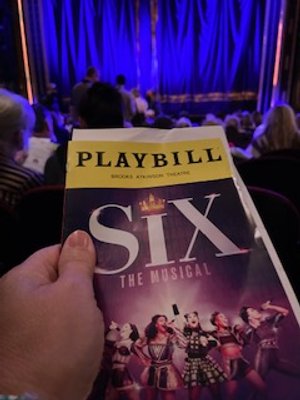#52 Learning History on Broadway
When you happen to be in New York City for the weekend celebrating a family wedding, what better time than to cram in a couple of Broadway plays. You honestly don’t even need to plan too far in advance. Tickets are widely available.
Hundreds of people queue up at the TKTS booth run by the Theatre Development Fund in Father Duffy Square, right in the middle of the Broadway theatre district. The plays available are listed on multiple electronic signs and the long lines move quickly, so don’t let that deter you. It is VERY important to know that the line for musicals is on one side (east side) and the dramas are on the other (west side) of the building. Knowing that may save you well over a half hour.
It is well worth knowing that the tickets sold at TKTS are the best seats available so you will still spend a pretty penny for tickets. A $500 orchestra seat will be a relative bargain at a reduced rate or half off. The “cheap” seats will likely not be sold at a discount at Duffy Square.
For the people with time and persistence, a trip directly to the box office is well worth the effort. We were able to get tickets that were not advertised on the show’s website managed by Ticketmaster. Plus, you avoid many of the surcharges. This adds up when you buy several tickets. One may ask if any “Rush” seats are available for that day’s performances. One fellow in line behind us snagged a $39 seat for the matinee.
Rush tickets are a quota of heavily discounted tickets that are sold at the box office on the day of the performance when there are still a few unsold seats. Rush tickets are often sold at half the price (or more) of the actual ticket! This practice was started initially to sell the last unsold seats and boast a sold-out show. Rush tickets make Broadway affordable for those who are ready to wait till the last minute.
For Saturday afternoon, afternoon we got seats for the final preview performance of Leopoldstadt. The Broadway run of an award-winning play by revered playwright, Tom Stoppard. The play follows the history of an extended Austrian Jewish family that begins in 1899. We follow the family through to 1955. The family of mathematicians, intellectuals and wealthy merchants thinks it is too assimilated into society to be in danger when the Nazis arrive. Of course, we know that they are completely wrong.
What we did not know, was how the arc of the play resembles the history of Stoppard himself, born Tomáš Sträussler, into a Jewish family in Prague, and receiving his new last name just as the protagonist in the play, from an English stepfather. Apparently, Stoppard, who is 85 years old, did not even know of his own Jewish ancestry until the 1990’s. This work serves to shine the light on much of his family’s past. The work covers many generations and issues such as the rise of Zionism and the looting (and attempted retrieval) of the family’s prized piece of artwork. The characters wrestle with their most optimistic hopes and live in denial of their pessimistic reality. They don’t know what they don’t know.
After that emotional experience, like any good Jewish family, we could turn to a celebration. We dressed in our formal wear and attended the family wedding. It did not disappoint. The flower draped wedding canopy was splendid over the young couple and their families. Afterwards, we moved to a boisterous reception with flowing food, drink, and dancing. First, a hora with chair hoisting of the bride and groom and their parents. Then came an excellent mix of dance tunes to keep everyone happy. Getting the extended family together was a real joy.
On Sunday, the matinee performance of Six on Broadway started at 2. We bought our tickets at the box office the day before. They appeared to be tickets that we did not see in the on-line offerings. Six is another show from the West End of London that has opened in multiple cities. In a pop musical format, the show tells the story of the six wives of Henry the Eighth in a way you’ve quite never heard them before. The six ill-fated wives introduce themselves as “divorced, beheaded, died; divorced, beheaded, survived” are hosting a concert/contest for the audience to determine which wife had it the worst. Each queen sings her own song to tell the story of her tragic life. Each queen is used, abused, and discarded in the worst possible ways.
To paraphrase the show, we get to rewrite her story, not his story. These ladies, as were all women until quite recently, were relegated to utter dependence on their husbands or male relatives for financial support. Co-writers Toby Marlow and Lucy Moss pair each queen to her own musical style and model each after modern pop stars such as Adele, Beyonce, and others. They are packed up by a talented all-lady band and complemented by futuristic costumes and set effects. This show is a rollicking good time.
In two days, we saw two plays framing history in radically different ways. Lessons from the recent and distant past can absolutely be taught in a most entertaining way on the Broadway stage. For example, in Hamilton, I learned that Thomas Jefferson could rap like a rock star. In Come from Away, I learned about the shared humanity of residents and stranded passengers who found themselves together in Newfoundland on the day of and after the attacks of September 11, 2001. Our playwrights don’t need to look too far for inspiration. They can just go to their history books.




